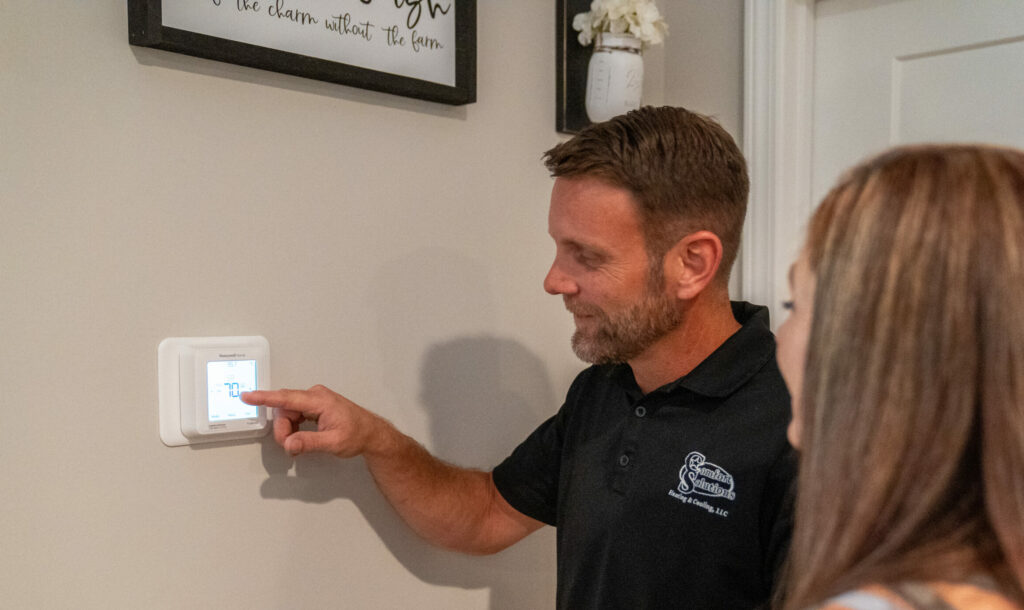
Air conditioning is a modern luxury—nearly 90% of homes in the United States use some form of air conditioning, and two out of every three homes have central cooling. Most days, you may not think much about your HVAC unit, but when things start heating up indoors on warm days, you’ll certainly take notice.
Sometimes, your air conditioning malfunction isn’t due to your unit but to your thermostat. Here’s how to know if the little device that controls your home’s indoor temperature needs to be replaced.
4 Signs Your Thermostat Needs an Upgrade
1. Your HVAC system won’t respond to your thermostat.
When warmer weather arrives, you’ll most likely switch your system from heat to cool or bump the temperature down a few degrees. As soon as you adjust your thermostat settings, you will typically hear your system turn on with a click–and shortly afterward, you’ll feel the indoor temperature change.
If you’re adjusting your thermostat settings to no avail, you may need a new thermostat. If your indoor temperature is more than a couple of degrees above or below your set temperature, something is amiss.
Your unit may not be turning on and off at all, or it may be receiving faulty thermostat instructions. Either way, it’s time to call a local HVAC expert in Georgia for a thermostat upgrade.
2. Your thermostat is reading the indoor temperature incorrectly.
When working properly, your thermostat reads the indoor air temperature to ensure your system keeps your home at your desired level of comfort. However, when thermostats malfunction or break, they cannot monitor the air in your home, leading to excessively hot or cold conditions inside your home.
Not sure if your thermostat is reading the temperature correctly? Test it by comparing your thermostat reading to that of a portable indoor thermometer. If there’s a large discrepancy in those readings, you may need to service or replace the thermostat to keep those indoor temperatures comfortable.
3. Your thermostat is outdated.
Technology is constantly improving, and this is true in HVAC technology. On average, most home thermostats today have a ten-year lifespan. Older thermostats lack digital screens and programming abilities, which can lead to higher energy costs and lower efficiency.
Consider upgrading your thermostat to a programmable option. This allows you to create a schedule for heating and cooling that works best for your specific needs at home. Most programmable thermostats offer advanced features, like app controls and daily schedules, that can help you save money and stay comfortable all year long.
4. Your energy bill is suddenly higher.
Most people are looking for ways to save money on AC and heating costs, so noticing an unexpected jump on your bill can be alarming. Your HVAC unit may be short-cycling, which happens when it cannot complete a full cooling (or heating) cycle.
Early shutoffs lead to ineffective heating and cooling, which causes higher energy costs and a less comfortable home environment. When your thermostat is not working properly, it sends the wrong messages to your unit, consuming more energy.
How to Troubleshoot Your Thermostat
If your thermostat is experiencing issues, you may be able to find a simple fix at home. Here’s what we suggest:
- Reset your thermostat. All digital devices can malfunction from time to time, so follow the manufacturer’s instructions to reboot your system.
- Change the batteries. If you find a blank display screen, you may need to replace the batteries in your thermostat to get things working properly again. If your thermostat does not run on batteries, move on to step three.
- Check for dust, corrosion, or loose wiring. Sometimes, thermostats malfunction due to manual problems, like dust inside the unit or wires that have grown loose over time. If you’re concerned about checking these things yourself, call your local HVAC professional.
- Check your circuit breakers. Your thermostat may be connected to a breaker that has lost power. Resetting or replacing a dysfunctional breaker can get your thermostat working again.
When To Call In The HVAC Professionals
If none of these troubleshooting steps resolve your thermostat issues, it’s time to call for reinforcements. Stop wondering if your home’s climate control will work and give Comfort Solutions Heating and Cooling a call instead. Our experienced technicians can identify the cause of your HVAC issues and help you resolve the issue with expert care.
If you need a thermostat replacement, we’ll diagnose the issue, review your options for a new thermostat, and test your system with the new thermostat to ensure everything is working perfectly. Thankfully, thermostat replacement is typically a simple and cost-effective process!
If the thermostat is not to blame for the air conditioning problems in your home, our experts can repair or replace your AC unit to keep you cool and comfortable. We can help to repair almost any air conditioning system, and we install Rheem units—some of the most durable, cost-effective, and environmentally friendly systems on the market.
Need HVAC help? Schedule an appointment with Comfort Solutions today!
